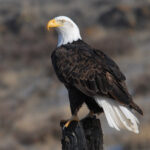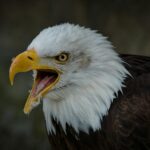Yes, there are bald eagles in Yellowstone National Park. According to the latest data, there are currently about 29 nesting pairs of bald eagles in the park. This number represents a significant increase from the 1960s, when there were only around 400 breeding pairs left in the lower 48 states due to hunting, habitat destruction, and growing pesticide use.
The Comeback of Bald Eagles in Yellowstone
Bald eagles were once on the brink of extinction in the United States, but thanks to conservation efforts, their population has made a remarkable comeback. In 1978, the bald eagle was placed on the Endangered Species List, and stricter restrictions were placed on the use of the pesticide DDT, which had been causing eggshell thinning and reproductive failure in the birds.
As a result of these protective measures, the bald eagle population has rebounded, with an estimated 5,000 nesting pairs in the contiguous United States today. Yellowstone National Park has played a significant role in this recovery, with the park’s diverse habitats and abundant food sources providing an ideal environment for bald eagles to thrive.
Where to Spot Bald Eagles in Yellowstone
Bald eagles in Yellowstone primarily feed on fish, but they also consume waterfowl and carrion. The best places to spot these majestic birds in the park include:
- Hayden Valley: This expansive valley is known for its abundant wildlife, including bald eagles that can be seen year-round.
- Madison River: The Madison River, which flows through the park, is a popular fishing spot for bald eagles.
- Yellowstone Lake: During the summer months, bald eagles can be spotted around the shores of Yellowstone Lake.
- Gardner River: In the winter, bald eagles may be seen near the Gardner River in the northwestern part of the park.
To increase your chances of spotting a bald eagle, look for their large nests atop tall trees and scan the skies nearby for a glimpse of these impressive birds in flight.
Bald Eagle Characteristics
Bald eagles in Yellowstone are known for their impressive size, with bodies that can be three feet (one meter) long and wingspans that can reach eight feet (2.4 meters) across. Adult eagles in the park are year-round residents, but some young eagles migrate in the fall to the west coast, and some adults return to their nesting sites by late winter.
Here are some key characteristics of bald eagles in Yellowstone:
| Characteristic | Description |
|---|---|
| Body Length | 3 feet (1 meter) |
| Wingspan | 8 feet (2.4 meters) |
| Resident Status | Adult eagles are year-round residents, while some young eagles migrate in the fall |
| Nesting | Bald eagles build large nests atop tall trees |
| Diet | Primarily fish, but also waterfowl and carrion |
The Importance of Bald Eagles in Yellowstone’s Ecosystem
Bald eagles play a crucial role in the Yellowstone ecosystem, serving as both predators and scavengers. As top-level predators, they help to maintain the balance of the park’s food web by preying on fish, waterfowl, and other small animals. Additionally, as scavengers, they help to clean up the environment by consuming carrion, which can help to prevent the spread of disease.
The presence of bald eagles in Yellowstone is also a testament to the park’s overall ecological health. As apex predators, bald eagles are sensitive to environmental changes and can serve as indicators of the overall health of the ecosystem. By monitoring the bald eagle population in Yellowstone, scientists can gain valuable insights into the park’s overall environmental conditions and make informed decisions about conservation and management strategies.
Conclusion
In conclusion, the presence of bald eagles in Yellowstone National Park is a testament to the success of conservation efforts and the park’s overall ecological health. With around 29 nesting pairs currently in the park, bald eagles have made a remarkable comeback, and visitors to Yellowstone have the opportunity to witness these majestic birds in their natural habitat. By understanding the importance of bald eagles in the Yellowstone ecosystem and the factors that have contributed to their recovery, we can continue to protect and preserve these iconic birds for generations to come.




